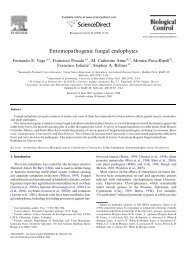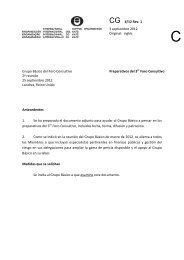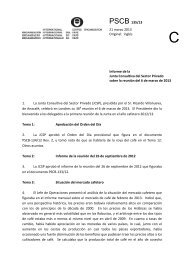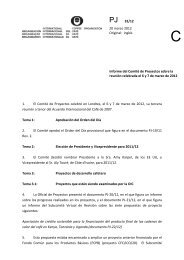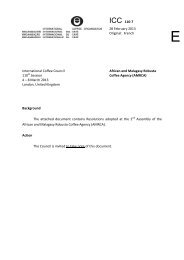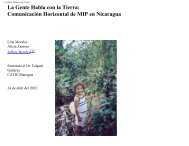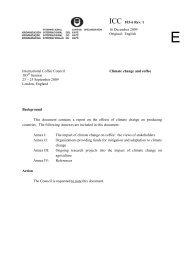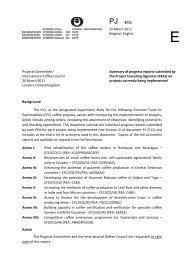Devouring profit - International Coffee Organization
Devouring profit - International Coffee Organization
Devouring profit - International Coffee Organization
Create successful ePaper yourself
Turn your PDF publications into a flip-book with our unique Google optimized e-Paper software.
export about 20,000 tonnes (something like 6.7% of total coffee exports) per annum<br />
in the next few years. Organic coffee is also of increasing interest especially for coffee<br />
grown on tribal land, which represents about 42% of the coffee area in India. Here<br />
coffee is managed in a less intensive traditional way, which is close to organic production<br />
guidelines (Central <strong>Coffee</strong> Research Institute, 2000). Some of the grades of specialty<br />
coffee and value added coffee are Mysore nuggets EB, Monsooned Malabar (AA, PB,<br />
C), Monsooned Arabica AA, Rob Kapi Royale.<br />
The states of Karnataka, Kerala and Tamil Nadu contribute 92% of Indian coffee grown<br />
but also in small sectors of the states of Andhra Pradesh and Orissa and some of the<br />
North Eastern states, coffee can also be found. In Andhra Pradesh at least, its is becoming<br />
a significant crop to tribes who formerly practised ‘slash-and-burn’ agriculture.<br />
Ecuador<br />
At US$100 million per year in 1999 coffee was about third in importance in agricultural<br />
exports of Ecuador, after fruit (mainly bananas) and shellfish and fourth in importance<br />
of all exports. Hence coffee provides a significant contribution to export earnings of<br />
this small and poor country. More importantly, the employment coffee traditionally<br />
provides makes it a crop of strategic and social importance. Both coffee and cocoa<br />
sustained pronounced falls for the period 1995-1998, whilst fruit and fish remained<br />
relatively stable. Part of the decline may be attributed to the El Niño phenomenon in<br />
1998, but it is clear that in the case of coffee the fall predates this event. From 1994<br />
to 1999, coffee export earnings fell by a stunning 81%, though these figures may be<br />
distorted somewhat by illegal movements of coffee to and from Colombia, depending<br />
on the differential in internal prices between those two countries.<br />
The 1983 national coffee census estimated that Ecuador had 460,000 ha of coffee but<br />
now it is reckoned to be only 305,000 ha. This reduction is most likely caused by<br />
abandonment of farms and changing to other crops as the world price of coffee has<br />
deteriorated. In order to measure the precise area, a coffee census is currently being<br />
carried out by INEC (Instituto Nacional de Estadística y Censos). Of this area roughly<br />
45% (137,000 ha) is planted to robusta coffee and 55% (168,000 ha) is arabica coffee.<br />
<strong>Coffee</strong> distribution, by geographical zones, appears in the following Table 37.<br />
The north-eastern zone of the country, corresponding to the Amazonian basin, is mainly<br />
Table 37. Geographic zones and areas in coffee.<br />
99




